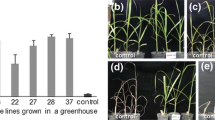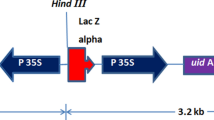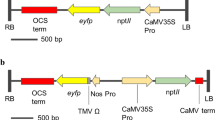Abstract
Stable inheritance of the transgene, consistent expression and competitive agronomic properties of transgenic crops are important parameters for successful use of the latter. These properties have been analyzed with 18 homozygous transgenic barley lines of the cultivar Golden Promise. The lines originated from three independent primary transformants obtained by the biolistic method with three plasmids containing respectively, the bar gene, the uidA gene and the gene for a protein-engineered heat-stable (1,3–1,4)-β-glucanase. Three production levels of recombinant β-glucanase were identified in homozygous transgenic T3 plants, and these remained constant over a 3-year period. In micro-malting experiments, the heat-stable enzyme reached levels of up to 1.4 µg·mg−1 protein and survived kiln drying at levels of 70–100%. In the field trials of 1997 and 1998 the transgenic lines had a reduced 1000-grain weight as well as variable yield depressions compared to the Golden Promise progenitor. In 1999 large-scale propagations of the lines with the highest recombinant enzyme synthesis during germination and of Golden Promise were studied at three different locations. In an irrigated field transgenic lines yielded approximately 6 t·ha−1 and Golden Promise 7.7 t·ha−1. Cross-breeding was carried out to transfer the transgene into a more suitable genetic background. Crosses of the semi-dwarf ari-e mutant Golden Promise gave rise to the four morphological phenotypes nutans, high erect, erect, and ari-e. Two improvements were achieved: (1) F3 lines homozygous for the expression of heat-stable (1,3−1,4)-β-glucanase were found among lines that were homozygous for each of the four morphological phenotypes; (2) improved 1000-grain weights and yields with respect to those of the original transformants were observed in some F4 lines homozygous for the morphological phenotypes and for the transgene. In the case of a homozygous nutans line, the transgenic plants had a higher 1000-grain weight than those lacking the transgene. Like mutants providing useful output traits, transgenic plants will often have to be improved by relocating the gene into more suitable genotypes.
Similar content being viewed by others
Author information
Authors and Affiliations
Additional information
Received: 6 March 2000 / Accepted: 14 April 2000
Rights and permissions
About this article
Cite this article
Horvath, H., Jensen, L., Wong, O. et al. Stability of transgene expression, field performance and recombination breeding of transformed barley lines. Theor Appl Genet 102, 1–11 (2001). https://doi.org/10.1007/s001220051612
Issue Date:
DOI: https://doi.org/10.1007/s001220051612




